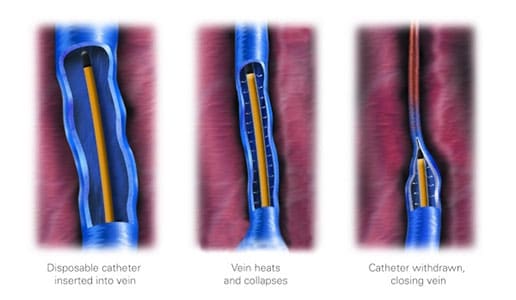RadioFrequency Ablation: How it works
Perhaps the most important thing to know about Radiofrequency Vein Ablation, is that it has a high success rate in treatment of varicose veins. Additionally, it is minimally invasive, minimally painful, has low rates of complication, can be performed in-office, and has a very rapid recovery time, usually about a day.
The Venous Ablation Process
 Introduced in 1999, radiofrequency vein ablation has helped to further revolutionize the management of superficial venous reflux disease, or Chronic Venous Insufficiency, and varicose veins. Using ultrasound to guide them, a vein specialists charged catheter delivers 350-500KHz of radio energy along the path of damaged veins. The affected veins close and are resorbed by the body, and blood flow is rerouted through healthy veins. Prior to operating the RF device, the adjacent tissues are surrounded by a tumescent solution, protecting the area and preventing the patient from feeling discomfort from the heat energy.
Introduced in 1999, radiofrequency vein ablation has helped to further revolutionize the management of superficial venous reflux disease, or Chronic Venous Insufficiency, and varicose veins. Using ultrasound to guide them, a vein specialists charged catheter delivers 350-500KHz of radio energy along the path of damaged veins. The affected veins close and are resorbed by the body, and blood flow is rerouted through healthy veins. Prior to operating the RF device, the adjacent tissues are surrounded by a tumescent solution, protecting the area and preventing the patient from feeling discomfort from the heat energy.
The procedure is very effective in the treatment of large vein varicosities including; the great saphenous vein, small saphenous vein, and perforator veins which link the superficial venous system to the deeper veins.
Learn More about RadioFrequency Vein Ablation
When performed by an experienced, qualified Vein Specialist, success rates for radiofrequency ablation exceed 97%. To see whether you can benefit from this advanced varicose vein treatment, book a consultation and exam with a qualified vein specialist.
References:
https://www.ncbi.nlm.nih.gov/pmc/articles/PMC3377553/: retrieved October 15, 2016
Congratulations, you are pregnant! Your bundle or bundles of joy are on the way to change your life forever! The body changes quickly during pregnancy, and some of these changes are not so wonderful! Varicose veins are a common occurrence in pregnancy. There are a number of reasons for this: blood volume increases, hormones shift,…
Read More- « Previous
- 1
- …
- 13
- 14
- 15

